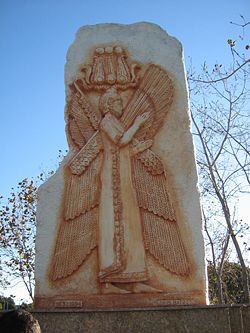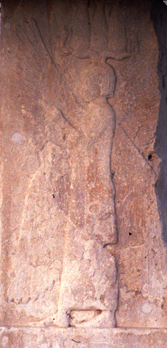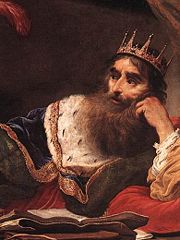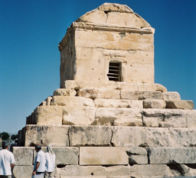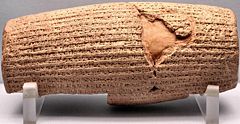Cyrus the Great
2008/9 Schools Wikipedia Selection. Related subjects: Historical figures
| Cyrus II the Great | |
| King of Persia, King of Anshan, King of Media, King of Babylon | |
| Reign | 559 BC-529 BC |
|---|---|
| Coronation | Anshan, Persis |
| Born | 590 BC or 576 BC |
| Birthplace | Anshan, Persis |
| Died | August?, 530 BC or 529 BC |
| Place of death | Along the Syr Darya |
| Buried | Pasargadae |
| Predecessor | Cambyses I |
| Successor | Cambyses II |
| Consort | Cassadane of Persia |
| Offspring | Cambyses II Smerdis Artystone Atossa Unamed unknown |
| Royal House | Achaemenid |
| Father | Cambyses I of Persia |
| Mother | Mandane of Media? |
| Religious beliefs | Zoroastrianism? |
|
|||||
Cyrus the Great ( Old Persian: 𐎤𐎢𐎽𐎢𐏁, Kūruš, modern Persian: کوروش بزرگ, Kurosh-e Buzurg or کوروش کبیر Kurosh-e Kabeer (c. 590 BC or 576 — August 529 BC or 530 BC), also known as Cyrus II of Persia and Cyrus the Elder, was a Persian Shāhanshāh ( Emperor). He was the founder of the Persian Empire under the Achaemenid dynasty. The empire expanded under his rule, eventually conquering most of Southwest Asia and much of Central Asia, from Egypt and the Hellespont in the west to the Indus River in the east, to create the largest state the world had yet seen.
During his twenty-nine to thirty year reign, Cyrus fought against some of the greatest states of his time, including the Median Empire, the Lydian Empire, and the Neo-Babylonian Empire. Cyrus did not venture into Egypt, as he himself died in battle, fighting the Scythians along the Syr Darya in August 529 BC or 530BC. He was succeeded by his son, Cambyses II, who managed to conquer Egypt during his short rule.
Beyond his nation, Cyrus left a lasting legacy on Jewish religion (through his Edict of Restoration), human rights, politics, and military strategy, as well as on both Eastern and Western civilization.
Etymology
The ancient historians Ctesias and Plutarch noted that Cyrus was named from Kuros, the sun, a concept which has been interpreted as meaning "like the sun," by noting its relation to the Persian noun for sun, khor, while using -vash as a suffix of likeness. However, some modern historians, such as Karl Hoffmann and Rüdiger Schmitt of the Encyclopædia Iranica, have suggested the translation "humiliator of the enemy in verbal contest."
In modern Persia, Cyrus is referred to as Kourosh-e Kabir, and, more recently, as Kourosh-e Bozorg — the Persian-derived name for Cyrus the Great. In the Bible, he is known as simply Koresh (Hebrew: כורש). He is also possibly mentioned in the Qur'an under the title " Dhul-Qarnayn" ذو القرنين, who conquered lands east and west.
Dynastic history
Similar to other culture-heroes and founders of great empires, folk traditions abound regarding his family background. According to the Herodotus, he was the grandson of the Median king Astyages and was brought up by humble herding folk. In another version, he was presented as the son of poor parents who worked in the Median court. These folk stories are however contradicted by his own testimony according to which he was preceded as king of Persia by his father, grandfather and great-grandfather. Out of the many Persian tribes, he was from the Pasargadae. And was descended from one of its clans, which was the Achaemenidae. Before he united the Persians and Medes under a single empire, he was the ruler of Anshān, then a vassal kingdom of the Median Empire, in what is now part of Fars Province in southern Iran. In this area Cyrus would build Pasargadae, his future capital city.
The dynasty had supposedly been founded by Achaemenes (c. 700 BC?), who was succeeded by his son Teispes of Anshan. Inscriptions indicate that when the latter died, two of his sons shared the throne as Cyrus I of Anshan and Ariaramnes of Persia. They were succeeded by their respective sons Cambyses I of Anshan and Arsames of Persia. However, the authenticity of these inscriptions has been called into question, thus blurring the history of Cyrus' predecessors.
Cambyses is considered by Herodotus to be of good family but not a king, and further notes his marriage to Princess Māndānā, who was the daughter of Princess Aryenis of Lydia (or of another wife according to Christian Settipani) and Astyages, king of the Medes. From their union, Māndānā bore only one son, Cyrus II, better known today as Cyrus the Great, whom Cambyses named after the child's grandfather.
According to Ctesias, Cyrus the Great married a daughter of Astyages named Amytis, which seems unlikely, as his wife would also be his aunt. A possible explanation is that Astyages married again, and his second wife bore him this daughter. Cyrus' first wife, Cassandane, is equally obscure. According to Herodotus and the Behistun Inscription, she bore Cyrus at least two sons, Cambyses II and Smerdis. Both sons later separately ruled Persia for a short period of time. Cyrus also had several daughters, of which two, Artystone and Atossa, would marry Darius the Great. The latter is significant, as she gave birth to Xerxes I, Darius' successor.
Early life
Cyrus was born in 583 BC. Little is known of his early years, as the sources detailing that part of his life are few, and have been damaged or lost.
Herodotus's story of Cyrus' early life belongs to a genre of legends in which abandoned children of noble birth, such as Oedipus and Romulus and Remus, return to claim their royal positions. His overlord was his own grandfather, Astyages, ruler of the powerful Median kingdom.
After the birth of Cyrus, Astyages had a dream that his Magi interpreted as a sign that his grandson would eventually overthrow him. He then ordered his steward Harpagus to kill the infant. Harpagus, morally unable to kill a newborn, summoned a herdsman of the king named Mithridates and ordered him to dispose of the child. Luckily for the young boy, the herdsman took him in and raised him as his own.
When Cyrus was ten years old, Herodotus claims that it was obvious that Cyrus was not a herdsman's son, stating that his behaviour was too noble. Astyages interviewed the boy and noticed that they resembled each other. Astyages ordered Harpagus to explain what he had done with the baby, and after confessing that he had not killed the boy, the king tricked him into eating his own broiled and chopped son. Astyages was more lenient with Cyrus, and allowed him to return to his biological parents, Cambyses and Mandane. While Herodotus' description may be a legend, it does give insight into the figures surrounding Cyrus the Great's early life.
Rise and military campaigns
Lydian Empire and Asia Minor
The exact dates of the Lydian conquest are unknown, but it must have taken place between Cyrus' overthrow of the Mede kingdom (550 BC)) and his conquest of Babylon (539 BC). It was common in the past to give 547 BC as the year of the conquest due to some interpretations of the Nabonidus Chronicle, but this position is currently not much held. The Lydians first attacked the Achaemenid Empire's city of Pteria in Cappadocia. Croesus laid siege to the city, and captured its inhabitants as slaves. Meanwhile, The Persians invited the citizens of Ionia, who were part of the Lydian kingdom, to revolt against their ruler. The offer was rebuffed, and thus Cyrus levied an army and marched against the Lydians, increasing his numbers while passing through nations in his way. The Battle of Pteria was effectively a stalemate, with both sides suffering heavy casualties by nightfall. Croesus retreated to Sardis the following morning.
While in Sardis, Croesus sent out requests for his allies to send aid to Lydia. However, near the end of winter, before the allies could unite, Cyrus pushed the war into Lydian territory and besieged Croesus in his capital, Sardis. Shortly before the final Battle of Thymbra between the two rulers, Harpagus advised Cyrus to place his dromedaries in front of his warriors; the Lydian horses, not used to the dromedaries' smell, would be very afraid. The strategy worked; the Lydian cavalry was routed. Cyrus defeated and captured Croesus. Cyrus occupied the capital at Sardis, conquering the Lydian kingdom in 546 BC. According to Herodotus, Cyrus spared Croesus' life and kept him as an advisor, but this account conflicts with some translations of the contemporary Nabonidus Chronicle, which interpret that the king of Lydia was slain.
Before returning to the capital, a Lydian named Pactyes was entrusted by Cyrus to send Croesus' treasury to Persia. However, soon after Cyrus' departure, Pactyes hired mercenaries and caused an uprising in Sardis, revolting against the Persian satrap of Lydia, Tabalus. With recommendations from Croesus that he should turn the minds of the Lydian people to luxury, Cyrus sent Mazares, one of his commanders, to subdue the insurrection, but demanded that Pactyas be returned alive. Upon Mazares' arrival, Pactyas fled to Ionia, where he had hired mercenaries. Mazares marched his troops into the Greek country and captured the cities of Magnesia and Priene, where Pactyas was captured and sent back to Persia for punishment.
Mazares continued the conquest of Asia Minor, but died of unknown causes during his campaign in Ionia. Cyrus sent Harpagus to complete Mazares' conquest of Asia Minor. Harpagus captured Lycia, Cilicia and Phoenicia, using the technique of building earthworks to breach the walls of besieged cities, a method unknown to the Greeks. He ended his conquest of the area in 542 BC, and returned to Persia.
Neo-Babylonian Empire
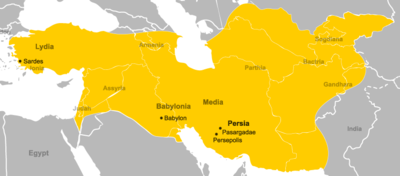
In 539 BC, towards the end of September, Cyrus' armies, under the command of Gubaru, the governor of Gutium, attacked Opis on the Tigris river and defeated the Babylonians after a minor uprising. With Opis subjugated, the Persians took control of the vast canal system of Babylonia.
On October 10, the city of Sippar was seized without a battle, with little to no resistance from the populace. It is probable that Cyrus engaged in negotiations with the Babylonian generals to obtain a compromise on their part and therefore avoid an armed confrontation. Nabonidus was staying in the city at the time, and soon fled to the capital, Babylon, which he had not visited in years.
Two days later, on October 12 (Julian calendar; October 7 by the Gregorian calendar), Gubaru's troops entered Babylon, again without any resistance from the Babylonian armies. Herodotus explains that to accomplish this feat, the Persians diverted the Euphrates river into a canal so that the water level dropped "to the height of the middle of a man's thigh," which allowed the invading forces to march directly through the river bed to enter at night. On October 29, Cyrus himself entered the city of Babylon and arrested Nabonidus. He then assumed the titles of "king of Babylon, king of Sumer and Akkad, king of the four sides of the world."
Prior to Cyrus' invasion of Babylon, the Neo-Babylonian Empire had conquered many kingdoms. In addition to Babylonia itself, Cyrus incorporated its subnational entities into his Empire, including Syria and Judea.
Before leaving Babylon, Cyrus also issued the "Edict of Restoration" ( Ezra 1:1-4), which freed the Jewish exiles by allowing them to return to their native land; this effectively ended the Babylonian captivity. His wife died on 498 B.C. The return of the exiles re-established the Jewish population in their homeland.
According to the Behistun Inscription of Darius the Great, Cyrus' dominions must have comprised the largest empire the world had ever seen. At the end of Cyrus' rule, the Achaemenid Empire stretched from Asia Minor and Judah in the west to the Indus River in the east.
Death
The details of Cyrus' death can vary by account. The account of Herodotus from his Histories provides the second longest detail, in which Cyrus met his fate in a fierce battle with the Massagetae, a tribe from the southern deserts of Kharesm and Kizilhoum in the southernmost portion of the steppe regions of modern-day Kazakhstan and Uzbekistan, following the advice of Croesus to attack them in their own territory.The Massagetae were related to the Scythians in their dress and mode of living; they fought on horseback and on foot. In order to acquire her realm, Cyrus first sent an offer of marriage to their ruler Tomyris, a proposal she rejected. He then commenced his attempt to take Massagetae territory by force, beginning by building bridges and towered war boats along his side of the river Araxes, or Sry Dara, which separated them. Sending him a warning to cease his encroachment in which she stated she expected he would disregard anyway, Tomyris challenged him to meet her forces in honorable warfare, inviting him to a location in her country a day's march from the river, where their two armies would formally engage each other. He accepted her offer, but, learning that the Massagetae were unfamiliar with wine and its intoxicating effects, he set up and then left camp with plenty of it behind, taking his best soldiers with him and leaving the least capable ones. The general of Tomyris's army, which was also her son Spargapises, and 1/3 of the Massagetian troops killed the group Cyrus had left there, and, finding the camp well-stocked with food and the wine, unwittingly drank themselves into inebriation, diminishing their capability to defend themselves when they were then overtaken by a surprise attack. They were successfully defeated, and although he was taken prisoner, Spargapises committed suicide once he regained sobriety. Upon learning of what had transpired, Tomyris denounced Cyrus' tactics as underhanded and swore vengeance, leading a second wave of troops into battle herself. Cyrus was ultimately killed and his forces suffered massive casualties in what Herodotus referred to as the fiercest battle of his career, and the ancient world. When it was over, Tomyris ordered the body of Cyrus brought to her, then decapitated him and dipped his head in a vessel of blood, in a symbolic gesture of revenge for his bloodlust and the death of her son. However, some scholars question this version, mostly when Herodotus says no was there to see the aftermath, but others suggest the persian troops may have later recovered the body, or that Tomyris beheaded a man other than Cyrus.
Ctesias, in his Persica, has the longest account which says Cyrus met his death while putting down resistence from the Derbices infantry. Which were aided by other Scythian archers and cavalry, plus Indians and their elephants. Which took place north-east of the headwaters of the Sry Darya.
An alternative account from Xenophon's Cyropaedia contradicts the others, claiming that Cyrus died peaceably at his capital..
The final version of Cyrus's death comes from Berossus. Which he only reports Cyrus met his death while warring against the Dahae archers north-west of the headwaters of the Sry Darya.
Tomb
Cyrus' remains were supposedly interred in the city of Pasargadae, where today a tomb still exists which many believe to be his. Both Strabo and Arrian give descriptions of the tomb, based on eyewitness reports from the time of Alexander the Great's invasion. Though the city itself is now in ruins, the burial place of Cyrus the Great has remained largely intact; and the tomb has been partially restored to counter its natural deterioration over the years. According to Plutarch, his epitaph said,
| “ | O man, whoever you are and wherever you come from, for I know you will come, I am Cyrus who won the Persians their empire. Do not therefore grudge me this little earth that covers my body. | ” |
Cuneiform evidence from Babylon proves that Cyrus died in August 530 BC, and that his son Cambyses II had become king. His younger son, Smerdis, died before Cambyses left to invade the eastern front. From Herodotus' account, Cambyses killed his brother to avoid a rebellion in his absence. Cambyses continued his father's policy of expansion, and managed to capture Egypt for the Empire, but soon died after only seven years of rule. An imposter named Gaumata, claiming to be Smerdis, became the sole ruler of Persia for seven months, until he was killed by Darius the Great.
Cyrus was praised in the Tanach ( Isaiah 45:1-6), though he was also criticized for believing the false report of the Cuthites, who wanted to halt the building of the Second Temple. They accused the Jews of conspiring to rebel, so Cyrus in turn stopped the construction of the temple, which would not be completed until 516 BCE, during the reign of Darius the Great, the grandson of Queen Esther.
Legacy
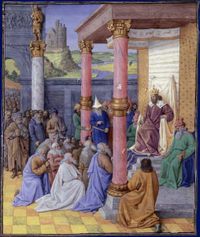
Cyrus was distinguished equally as a statesman and as a soldier. By pursuing a policy of generosity instead of repression, and by favoring local religions, he was able to make his newly conquered subjects into enthusiastic supporters. Due in part to the political infrastructure he created, the Achaemenid empire endured long after his demise.
The rise of Persia under Cyrus's rule had a profound impact on the course of world history. Persian philosophy, literature and religion all played dominant roles in world events for the next millennia. Despite the Islamic conquest of Persia in the 7th century CE by the Islamic Caliphate ( Arab Empire), Persia continued to exercise enormous influence in the Middle East during the Islamic Golden Age, and was particularly instrumental in the growth and expansion of Islam.
Many of the dynasties that followed the Achaemenids ( Seleucid, Sassanid, Pahlavi) have claimed to continue the line begun by Cyrus. Mohammad Reza Shah celebrated the 2500th anniversary of the Iranian monarchy in 1971, though it would be toppled a mere eight years later. Even some today consider him equal, if not greater than Alexander the Great, in size and scope.
Religion
The only known example of his religious policy is his treatment of the Jews in Babylon. The Bible records that a remnant of the Jewish population returned to the Promised Land from Babylon, following an edict from Cyrus to rebuild the temple. This edict is fully reproduced in the Book of Ezra. As a result of Cyrus' policies, the Jews honored him as a dignified and righteous king. He is the only Gentile to be designated as a messiah, a divinely-appointed king, in the Tanakh ( Isaiah 45:1-6). However, at the time, there was also Jewish criticism of him after he was lied to by the Cuthites, who wanted to halt the building of the Second Temple. They accused the Jews of conspiring to rebel, so Cyrus in turn stopped the construction of the temple, which would not be completed until 516 BC, during the reign of Darius the Great.
Some contemporary Muslim scholars have suggested that the Qur'anic figure of Dhul-Qarnayn is Cyrus the Great. This theory was proposed by Sunni scholar Abul Kalam Azad and endorsed by Shi'a scholars Allameh Tabatabaei, in his Tafsir al-Mizan and Makarem Shirazi and Sunni scholar Abul Ala Maududi.
Politics and philosophy
During his reign, Cyrus maintained control over a vast region of conquered kingdoms, achieved partly through retaining and expanding Median satrapies. Further organization of newly conquered territories into provinces ruled by vassal kings called satraps, was continued by Cyrus' successor Darius the Great. Cyrus' empire demanded only tribute and conscripts from many parts of the realm.
Cyrus' conquests began a new era in the age of empire building, where a vast superstate, comprising many dozens of countries, races, religions, and languages, were ruled under a single administration headed by a central government. This system lasted for centuries, and was retained both by the invading Seleucid dynasty during their control of Persia, and later Iranian dynasties including the Persian Parthians and Sassanids.
In 1992, he was ranked #87 on Michael H. Hart's list of the most influential figures in history. On December 10, 2003, in her acceptance of the Nobel Peace Prize, Shirin Ebadi evoked Cyrus, saying:
| “ | I am an Iranian, a descendant of Cyrus the Great. This emperor proclaimed at the pinnacle of power 2,500 years ago that he 'would not reign over the people if they did not wish it.' He promised not to force any person to change his religion and faith and guaranteed freedom for all. The Charter of Cyrus the Great should be studied in the history of human rights. | ” |
Cyrus' legacy has been felt even as far away as Iceland and colonial America. Many of the forefathers of the United States of America sought inspiration from Cyrus the Great through works such as Cyropaedia. Thomas Jefferson, for example, had two personal copies of the book, "which was a mandatory read for statesmen alongside Machiavelli's The Prince."
In a recent segment of ABC's Nightline with Ted Koppel, Ted Koppel mentioned Cyrus the Great, when he was talking about the new documentary film being made in his honour, and had this to say of him:
“Cyrus the Great is genuinely one of history's towering figures. America's own founders such as Thomas Jefferson were influenced by Cyrus the Great in the field of Human Rights.”
Cyrus Cylinder
The cylinder has been considered as the world's first known charter of human rights, as there are passages in the text have been translated and interpreted as expressing Cyrus’ respect for humanity. Following this interpretation, it appears to promote a form of religious tolerance and freedom, to allow Cyrus' subjects to continue worshipping their gods, despite his own religious beliefs, and even to restore the temples of foreign gods. Accepting this interpretation, in 1971 the United Nations published a translation of the document in all the official U.N. languages. A replica of the Cyrus Cylinder has reportedly been on display at United Nations headquarters in New York City as a tribute to Cyrus' display of respect and tolerance. Another replica, on a gold sheet, had been on display on the top floor of the Shahyad monument in South Tehran, to symbolize the connection between Cyrus and the (then) present ruler.
However, some scholars have rejected this view, arguing that the concept of human rights is alien to the historical context. The text played an important role in political propaganda in modern Iran. To support the interpretation of Cyrus as an early champion of human rights, some parts of the text even have been falsely translated.
Family tree
|
|
|
|
Achaemenes King of Persia*
|
|
|
|
|
|
|
|
|
|
|
|
|
|
|
|
|
|
|||||||||||||||||||||||||||
|
|
|
|
|
|
|
|
|
|
|
|
|
|
|
|
|
|
|
|
|
|
|
|
|
||||||||||||||||||||||||
|
|
|
|
Teispes King of Persia*
|
|
|
|
|
|
|
|
|
|
|
|
|
|
|
|
|
|
|||||||||||||||||||||||||||
|
|
|
|
|
|
|
|
|
|
|
|
|
|
|
|
|
|
|
|
|
|
|
|
|
|
|
||||||||||||||||||||||
|
|
|
|
|
|
|
||||||||||||||||||||||||||||||||||||||||||
|
|
Ariaramnes Ruler of Persia*
|
|
Cyrus I Ruler of Anshan*
|
|
|
|
|
|
|
|
|
|
|
|
|
|
|
|
|||||||||||||||||||||||||||||
|
|
|
|
|
|
|
|
|
|
|
|
|
|
|
|
|
|
|
|
|
|
|
|
|
|
|||||||||||||||||||||||
|
|
Arsames Ruler of Persia*
|
|
Cambyses I Ruler of Anshan*
|
|
|
|
|
|
|
|
|
|
|
|
|
|
|
|
|||||||||||||||||||||||||||||
|
|
|
|
|
|
|
|
|
|
|
|
|
|
|
|
|
|
|
|
|
|
|
|
|
|
|||||||||||||||||||||||
|
|
Hystaspes Prince
|
|
Cyrus II King of Persia
|
|
|
|
|
|
|
|
|
|
|
|
|
|
|
|
|||||||||||||||||||||||||||||
|
|
|
|
|
|
|
|
|
|
|
|
|
|
|
|
|
|
|
|
|
|
|
|
|
|
|
||||||||||||||||||||||
|
|
|
|
|
|
|
|
|
|
|
|
|
|
|
|
|||||||||||||||||||||||||||||||||
|
|
Darius I King of Persia
|
|
Cambyses II King of Persia
|
|
Smerdis Prince (imposter Gaumata ruled as Smerdis*)
|
|
Artystone Princess
|
|
Atossa Princess
|
|
|
|
|||||||||||||||||||||||||||||||||||
|
Cyrus the Great
Achaemenid dynasty Born: c. 590 BC or 576 BC Died: 529 BC |
||
| Preceded by Cambyses I |
King of Persia 559 BC–529 BC |
Succeeded by Cambyses II |
| Preceded by Astyages |
King of Media 550 BC–529 BC |
|
